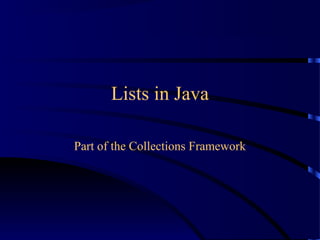
Lists
- 1. Lists in Java Part of the Collections Framework
- 2. Kinds of Collections • Collection--a group of objects, called elements – Set--An unordered collection with no duplicates • SortedSet--An ordered collection with no duplicates – List--an ordered collection, duplicates are allowed • Map--a collection that maps keys to values – SortedMap--a collection ordered by the keys • Note that there are two distinct hierarchies
- 3. Using Collections • import java.util.* or import java.util.Collection; • There is a sister class, java.util.Collections; that provides a number of algorithms for use with collections: sort, binarySearch, copy, shuffle, reverse, max, min, etc.
- 4. Collections are interfaces • Collection is actually an interface • Each kind of Collection has one or more implementations • You can create new kinds of Collections • When you implement an interface, you promise to supply the required methods • Some Collection methods are optional – How can an interface declare an optional method?
- 5. Creating a Collection • All Collection implementations should have two constructors: – A no-argument constructor to create an empty collection – A constructor with another Collection as argument • All the Sun-supplied implementations obey this rule, but-- • If you implement your own Collection type, this rule cannot be enforced, because an Interface cannot specify constructors
- 6. Collection: Basic operations int size( ); boolean isEmpty( ); boolean contains(Object element); boolean add(Object element); // Optional boolean remove(Object element); // Optional Iterator iterator( );
- 7. Collection: Iterator boolean hasNext( ); // true if there is another element Object next( ); // returns the next element (advances the iterator) void remove( ); // Optional // removes the element returned by next } public interface Iterator {
- 8. Using an Iterator • static void printAll (Collection coll) { Iterator iter = coll.iterator( ); while (iter.hasNext( )) { System.out.println(iter.next( ) ); } } • Note that this code is polymorphic--it will work for any collection
- 9. Collection: Bulk operations boolean containsAll(Collection c); boolean addAll(Collection c); // Optional boolean removeAll(Collection c); // Optional boolean retainAll(Collection c); // Optional void clear( ); // Optional • addAll, removeAll, retainAll return true if the object receiving the message was modified
- 10. Mixing Collection types • Note that most methods, such as boolean containsAll(Collection c); are defined for any type of Collection, and take any type of Collection as an argument • This makes it very easy to work with different types of Collections
- 11. singleton • Collections.singleton(e) returns an immutable set containing only the element e • c.removeAll(Collections.singleton(e)); will remove all occurrences of e from the Collection c
- 12. Collection: Array operations • Object[ ] toArray( ); – creates a new array of Objects • Object[ ] toArray(Object a[ ]); – Allows the caller to provide the array • Examples: Object[ ] a = c.toArray( ); String[ ] a; a = (String[ ]) c.toArray(new String[0]);
- 13. The List interface • A List is ordered and may have duplicates • Operations are exactly those for Collections int size( ); boolean isEmpty( ); boolean contains(Object e); boolean add(Object e); boolean remove(Object e); Iterator iterator( ); boolean containsAll(Collection c); boolean addAll(Collection c); boolean removeAll(Collection c); boolean retainAll(Collection c); void clear( ); Object[ ] toArray( ); Object[ ] toArray(Object a[ ]);
- 14. List implementations • List is an interface; you can’t say new List ( ) • There are two implementations: – LinkedList gives faster insertions and deletions – ArrayList gives faster random access • It’s poor style to expose the implementation, so: • Good: List list = new LinkedList ( ); Bad: LinkedList list = new LinkedList ( );
- 15. Inherited List methods • list.remove(e) removes the first e • add and addAll add to the end of the list • To append one list to another: list1.addAll(list2); • To append two lists into a new list: List list3 = new ArrayList(list1); list3.addAll(list2); • Again, it's good style to hide the implementation
- 16. List: Positional access Object get(int index); // Required -- // the rest are optional Object set(int index, Object element); void add(int index, Object element); Object remove(int index); abstract boolean addAll(int index, Collection c); • These operations are more efficient with the ArrayList implementation
- 17. List: Searching int indexOf(Object o); int lastIndexOf(Object o); • equals and hashCode work even if implementations are different
- 18. Interface List: Iteration • Iterators specific to Lists: ListIterator listIterator( ); ListIterator listIterator(int index); – starts at the position indicated (0 is first element) • Inherited methods: boolean hasNext( ); Object next( ); void remove( ); • Additional methods: boolean hasPrevious() Object previous()
- 19. List: Iterating backwards boolean hasPrevious( ); Object previous( ); int nextIndex( ); int previousIndex( ); • Think of the iterator as “between” elements • Hence, next followed by previous gives you the same element each time
- 20. List: More operations • void add(Object o); – Inserts an object at the cursor position • Object set(Object o); // Optional – Replace the current element; return the old one • Object remove(int index); // Optional – Remove and return the element at that position
- 21. List: Range-view • List subList(int from, int to); allows you to manipulate part of a list • A sublist may be used just like any other list
